|
|
|
ADVERTISEMENTS
|
|
PREMIUM
- HAPPY HOLIDAYS!
- Siliconeer Mobile App - Download Now
- Siliconeer - Multimedia Magazine - email-Subscription
- Avex Funding: Home Loans
- Comcast Xfinity Triple Play Voice - Internet - TV
- AKSHAY PATRA - Bay Area Event - Sat. Dec 6
- Calcoast Mortgage - Home Loans
- New Homes in Silicon Valley: City Ventures - Loden Place - Morgan Hill
- Bombay to Goa Restaurant, Sunnyvale
- Buying, Sellling Real Estate in Fremont, SF Bay Area, CA - Happy Living 4U - Realtor Ashok K. Gupta & Vijay Shah
- Sunnyvale Hindu Temple: December Events
- ARYA Global Cuisine, Cupertino - New Year's Eve Party - Belly Dancing and more
- Bhindi Jewellers - ROLEX
- Dadi Pariwar USA Foundation - Chappan Bhog - Sunnyvale Temple - Nov 16, 2014 - 1 PM
- India Chaat Cuisine, Sunnyvale
- Matrix Insurance Agency: Obamacare - New Healthcare Insurance Policies, Visitors Insurance and more
- New India Bazar: Groceries: Special Sale
- The Chugh Firm - Attorneys and CPAs
- California Temple Schedules
- Christ Church of India - Mela - Bharath to the Bay
- Taste of India - Fremont
- MILAN Indian Cuisine & Milan Sweet Center, Milpitas
- Shiva's Restaurant, Mountain View
- Indian Holiday Options: Vacation in India
- Sakoon Restaurant, Mountain View
- Bombay Garden Restaurants, SF Bay Area
- Law Offices of Mahesh Bajoria - Labor Law
- Sri Venkatesh Bhavan - Pleasanton - South Indian Food
- Alam Accountancy Corporation - Business & Tax Services
- Chaat Paradise, Mountain View & Fremont
- Chaat House, Fremont & Sunnyvale
- Balaji Temple - December Events
- God's Love
- Kids Castle, Newark Fremont: NEW COUPONS
- Pani Puri Company, Santa Clara
- Pandit Parashar (Astrologer)
- Acharya Krishna Kumar Pandey
- Astrologer Mahendra Swamy
- Raj Palace, San Jose: Six Dollars - 10 Samosas
CLASSIFIEDS
MULTIMEDIA VIDEO
|
|
|
|
|
NEWS DIARY | NOVEMBER:
Credit Crunch Hurts India’s Wealthiest, Too | Bangla Parties Start Campaigning for Landmark Polls | ISI Dissolved | Redistributing Wealth | Cities in Hell | Tigers Ambushed | Slow Going | Indo-Pak Talks
Credit Crunch Hurts India’s Wealthiest, Too
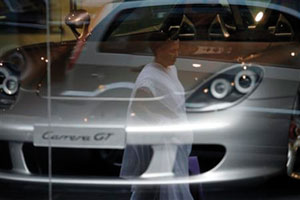 (Right): A woman walks past a car displayed at a Porsche showroom in Mumbai. The global economic crisis has hit India’s super rich. (Right): A woman walks past a car displayed at a Porsche showroom in Mumbai. The global economic crisis has hit India’s super rich.
These are painful times for India’s tycoons, the Forbes Asia Rich List said recently.
A falling stock market, a weak rupee and slowing economic growth have shaved about 60 percent off the wealth of India’s 40 richest people, it said in its annual compilation, with their net worth plunging to $139 billion from $351 billion a year ago.
No small change that, and it’s got to hurt.
“They’re definitely feeling the pain,” said Sonu Bhasin, president of retail finance at Axis Bank, and head of the bank’s private banking and wealth management divisions, which have nevertheless continued to add new clients in recent months.
“Everyone’s hurting, everyone’s in a panic, but the wealthy get noticed more and their concerns get addressed,” she said.
An economy that grew at about 9 percent in the last three years and a six-year bull run on the stock market helped mint new millionaires in Asia’s third-largest economy, a rich class who splashed out on luxury cars, yachts and sprawling vacation homes.
India had 123,000 millionaires in 2007 and showed the fastest pace of expansion, a Merrill Lynch/Capgemini report said.
But a stock market rout has meant local investors have “notionally lost almost a year’s GDP,” Credit Suisse said.
Lakshmi Mittal, chief of Arcelor Mittal, the world’s top steelmaker, gave up his No. 1 position on the Forbes list because of crashing prices.
The new No. 1, Mukesh Ambani, chief of Reliance Industries, has a net worth of about $21 billion, Forbes estimates, down 58 percent from last year. That does not seem to have hit construction of his $1 billion home.
Real estate tycoons such as top realtor DLF’s KP Singh have seen the biggest wealth erosion this year, Forbes noted, while windmill maker Suzlon’s founders have lost their billionaire status and flamboyant liquor baron Vijay Mallya, head of the UB Group, has dropped off the Forbes list on losses to his airline.
|TOP|
Bangla Parties Start Campaigning for Landmark Polls
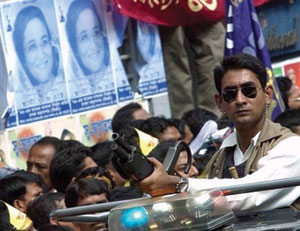 (Right): A plain clothes member of Bangladesh’s special security force stands guard outside the home of former Prime Minister Sheikh Hasina Wajed in Dhaka. Bangladesh swung into election mode after the country’s major political parties pledged to stand in a national poll Dec. 29. (Right): A plain clothes member of Bangladesh’s special security force stands guard outside the home of former Prime Minister Sheikh Hasina Wajed in Dhaka. Bangladesh swung into election mode after the country’s major political parties pledged to stand in a national poll Dec. 29.
Bangladesh swung into election mode after the country’s major political parties pledged to take part in a national poll Dec. 29 to restore democracy to the emergency-ruled country.
The vote, the first in seven years, had been planned for Dec. 18 but the caretaker government delayed it in order to secure the support of ex-premier Khaleda Zia’s Bangladesh Nationalist Party. Both the BNP and the Awami League — the country’s two main political forces — have committed to the new date, which will end almost two years of emergency rule.
BNP spokesman Khandaker Delwar Hossain said his party and its allies had started selecting candidates and would submit their names before the Nov. 30 cut-off date.
“We’ll seek nominations from our party officials today,” said Hossain, in the party’s first clear indication it would take part in the polls.
The BNP and its four-party Islamist alliance, which won the last election in 2001, had suspended polling preparations after the government earlier said it would not move the elections from Dec. 18.
The Awami League, led by ex-premier and Zia’s bitter rival Sheikh Hasina Wajed, announced it had accepted the new date.
“Our party has decided to participate in the Dec. 29 elections. We have accepted the changed date for the greater interest of the nation and for the restoration of democracy,” Awami League spokesman Abdul Mannan Khan told AFP.
Both parties have stepped up pressure on the government to lift emergency restrictions to make the polls free, fair and credible.
The government has not set a timetable but the independent election commission has urged the military-backed authorities to lift curbs at least two weeks before the election.
|TOP|
ISI Dissolved
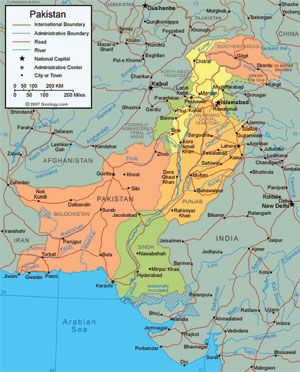 Pakistan has disbanded the political wing of the military intelligence agency, its foreign minister said Sunday. Pakistan has disbanded the political wing of the military intelligence agency, its foreign minister said Sunday.
The cooperation of Pakistan’s Inter-Services Intelligence, or ISI, directorate is regarded as vital to the West in fighting the threat of Al Qaeda globally and defeating the Taliban insurgency in Afghanistan.
But critics call it a “state within a state.” Pakistan’s eight-month-old civilian government has regularly accused the ISI’s political wing of involvement in the overthrow of their governments. Neighboring Afghanistan and India view the ISI with great distrust.
The Pakistani foreign minister, Shah Mahmood Qureshi, described the disbanding of the ISI’s political wing as a “positive development.”
“ISI is a precious national institution, and it wants to focus fully on counter-terrorism activities,” the state-run Associated Press of Pakistan quoted him as saying.
The army has ruled Pakistan for more than half its history since 1947. Consequently, issues related to the military are closely watched in the region as well as by Western allies of the nuclear-armed nation.
The latest chapter of military rule ended with the defeat of parties loyal to Pervez Musharraf in elections in February and Musharraf’s resignation as president in August.
His successor, President Asif Ali Zardari, and Prime Minister Yousaf Raza Gilani signaled their intention to exert more control over the ISI in July but backtracked from an attempt to bring it under the ambit of the Interior Ministry.
Senior officials say that the army chief, General Ashfaq Kayani, who himself served as ISI head, has been supportive of Pakistan’s return to civilian-led democracy while insisting that the army look after its own affairs.
|TOP|
Redistributing Wealth
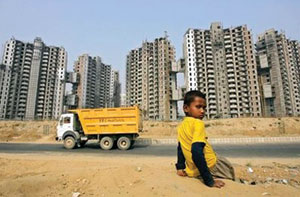 (Right): A poor boy sits with the backdrop of a plush residential complex in a partial state of construction, in Gorgon, India. Award-winning British journalist and author Alan Hart is looking for international experts to thrash out a policy for equitable redistribution of wealth in India. (Right): A poor boy sits with the backdrop of a plush residential complex in a partial state of construction, in Gorgon, India. Award-winning British journalist and author Alan Hart is looking for international experts to thrash out a policy for equitable redistribution of wealth in India.
Award-winning British journalist and author Alan Hart is on a mission to find 12 international experts — mainly economists — to thrash out a policy for equitable redistribution of wealth in India.
“I will fund the experts’ trip to India. They will have to debate the state of the country’s economy and present a paper on how to redistribute wealth in this country. We will network with private groups across India so that the paper is not thrown into the dustbin by the government. India is going to be an economic model for the rest of the world to follow,” Hart said.
The 65-year-old former Independent Television Network reporter believes that “India will be torn apart by rage” if steps are not taken quickly to redistribute wealth. He also fears that India’s pro-U.S. stand may harm the country.
“Look at the map of the world, India is surrounded by Muslim nations. It makes no sense for India to proceed this way as a puppet of the U.S., which is in alliance with Israel. The country is battling an economic crisis along with the rest of the world, which could lead to World War III.
“It needs to deflect the situation. India has a potentially huge middle class but more than 750 million people still live below the poverty line. It still accounts for 40 percent of the world’s poor,” the former BBC presenter said.
Hart identifies easily with poverty.
“I was born in an impoverished family in World War II Britain. My father juggled three jobs at a time, but I went to the best grammar school in Britain,” he said.
|TOP|
Cities in Hell
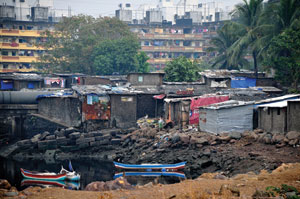 (Right): A Mumbai slum. (Right): A Mumbai slum.
Life in an Indian city for India’s millions of poor is worse than that in the American prison system, the British newspaper Guardian reports. Latest government figures reveal people in its cities live in just 60sq ft per person — the minimum size required by U.S. prisons.
The figures reveal that India’s handling of urbanization has become increasingly unsuccessful. Although the landscape of Indian cities is dotted with new apartment blocks and gated communities of white-washed mansions, these sit as small islands in seas of slums.
According the country’s 63rd national survey, 55 percent of India’s urban population live, sleep, cook and wash in a space no bigger than 10ft by 10ft. The comparable figure for the average American is 900 sq ft per person.
This year it is believed that the number of people living in urban areas globally exceeded those in the countryside for the first time ever — and India is forecast to have three of 10 largest “megapolises” by 2025.
Experts say that at the heart of the matter is the “routine denial of access to public services to the city poor.” Harsh Mander, a former civil servant who runs the Centre for Equity Studies, said that although the poor “subsidize the lifestyles of the middle class in India there is no concern for their well-being.”
Mander said government laws supposed to protect the poor are often subverted and zoning laws that forced builders to give over space to poor people for projects were simply used to “add extra bedrooms.”
“There is a deep prejudice about the poor. Their slums are demolished. They have no access to water or health facilities. In fact starting with housing they are denied access to public amenities and facilities. The state feels it has no duty to them.”
|TOP|
Tigers Ambushed
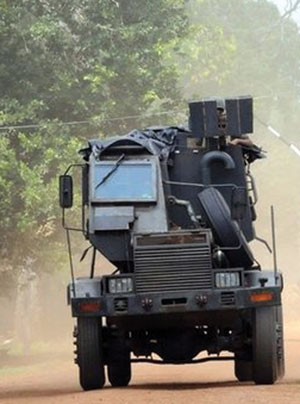 (Right): A Sri Lankan army armored vehicle in the war-hit northern town of Madhu. (Right): A Sri Lankan army armored vehicle in the war-hit northern town of Madhu.
Security forces ambushed and killed scores of Tamil Tigers in northern Sri Lanka Nov. 26, the Defense Ministry said, adding its troops were poised to take the rebels’ political capital.
Government soldiers occupying a newly-captured bunker line from the Tiger rebels in the Jaffna peninsula carried out the ambush early Nov. 25, the ministry said in a statement.
It did not say if there were casualties among troops.
However, the ministry said government soldiers in the northern mainland were set to take the town of Kilinochchi, the political capital of the Liberation Tigers of Tamil Eelam.
Heavy fighting was raging along three fronts on the outskirts of Kilinochchi despite monsoon rains, the ministry said.
“Soldiers are busy with strengthening the supply backbone for troops in the forward areas with loads of food, drinking water and medicine being transported there,” the ministry said.
“Troops await the next move. ‘Kilinochchi we are coming’ is their motto,” the statement added.
Earlier, the ministry said 27 soldiers had been killed and another 70 wounded in fighting around Kilinochchi. The Tigers said they killed 43 troops while the military claimed they had killed over 120 Tigers.
Sri Lanka’s government, which pulled out of a Norwegian-brokered truce in January, has vowed to take the Tiger’s political capital and dismantle the LTTE’s mini-state.
|TOP|
Slow Going
Nepal’s Maoists marked their 100th day in office, and the former rebels appear to have found treading the corridors of power as much of a challenge as fighting a guerrilla war.
Since the ultra-leftists took over running the new republic, progress on key issues has been slow or scant, diplomats and analysts say.
“It’s been hard for the Maoists to transform their strategy and tactics from the period of war to being in charge of the government,” said Lok Raj Baral, a political science professor from Tribhuvan University.
“Their cadre lack the political training that can transform them into participants in the democratic system,” he said.
Observers say the chief problem for Maoist Prime Minister Prachanda is what to do with his People’s Liberation Army — 19,000 guerrillas who have been confined to United Nations-monitored camps since a peace deal was struck in 2006.
Under the terms of Nepal’s peace process, the hardened former jungle and mountain fighters should be integrated into Nepal’s security forces, with the Maoists insisting their former guerrillas be admitted into the national army.
But the army, a bastion of Nepal’s former ruling elite, says it does not want to open its ranks to the highly indoctrinated former rebels.
“The peace process is stuck on the issue of integration and it’s not certain that it can be resolved any time soon,” said a Western diplomat on condition of anonymity.
Furthermore, some hardcore Maoists are seen as being reluctant to disband the force that helped get them into Kathmandu.
“The Maoists themselves are divided on this, with some of them wanting to keep their army intact as a tool to use in the elections that are due to be held in two years’ time,” the diplomat said.
|TOP|
Indo-Pak Talks
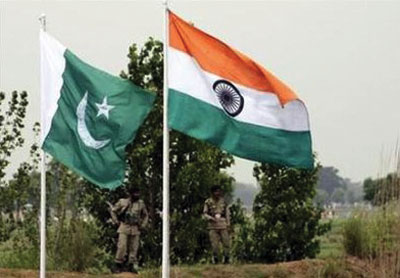 (Right): Pakistani rangers stand near the Indian and Pakistani national flags during an annual fair near Pakistan border in Chamliyal, 28 miles west of Jammu. (Right): Pakistani rangers stand near the Indian and Pakistani national flags during an annual fair near Pakistan border in Chamliyal, 28 miles west of Jammu.
Pakistan and India discussed cooperation in efforts to fight terrorism as part of a wide-ranging dialogue aimed at resolving outstanding disputes between the nuclear-armed rivals.
The talks between top Interior Ministry officials come after a spate of bomb attacks in both countries in recent months, and as Pakistan battles al Qaeda militants and their Pakistani allies who have unleashed a wave of violence across the country.
“The agenda of the talks include anti-terrorism measures, anti-narcotics measures, the exchange of civilian prisoners and cooperation between the FIA and the CID,” a Pakistani Interior Ministry spokesman said, referring to two countries’ main crime investigation agencies.
“It is certainly a confidence-building measure.”
The one-day security talks come a day before Pakistani Foreign Minister Shah Mehmood Qureshi is due to travel to India for a four-day visit, during which he will hold talks on all bilateral issues, a Foreign Ministry spokesman said.
The neighbors have fought three wars since their independence in 1947 and nearly went to war again in 2002. They launched a peace process in 2004 and have since taken several confidence-building measures that have led to better ties.
But they have made little progress on their main dispute over the Himalayan region of Kashmir, which both countries claim in full but rule in part.
|TOP|
|
|
|
|
|
|